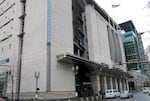
Mayor Ted Wheeler, Police Chief Chuck Lovell and District Attorney Mike Schmidt speak at a press conference Aug. 30, 2020, in Portland, Ore. A man was shot and killed the previous night as a Trump car caravan rolled through downtown.
Bradley W. Parks / OPB
The increasingly tense stalemate between the U.S. Department of Justice and city of Portland eased this week, as city officials took a softer stance during a meeting with federal prosecutors overseeing a 2014 settlement agreement.
The détente will likely halt what had been a steady march back to federal court.
At meeting held Tuesday — attended by Mayor Ted Wheeler, the city attorney, police bureau leadership, Commissioner Jo Ann Hardesty and representatives from all the other city commissioner’s offices — prosecutors with the DOJ’s civil rights division laid out nine suggested remedies to address Portland police falling out of compliance with the settlement agreement.
“I’m pleased to report that our discussion on Tuesday was very productive,” Assistant U.S. Attorney Jared Hager said at Thursday’s meeting of the Portland Committee on Community Engaged Policing. “It’s still a discussion, but I’m cautiously optimistic.”
Hager and Jonas Geissler, a senior trial attorney at the DOJ’s civil rights division, oversee the settlement agreement with the city. The two were joined at Thursday’s PCCEP meeting by City Attorney Robert Taylor and his deputy, Heidi Brown. Anil Karia, the Portland Police Association’s lawyer, also joined the meeting.
In a departure from previous meetings, lawyers for the city largely agreed with the federal prosecutors and cast an optimistic tone.
“Even where we maybe saw things differently, the places where we all agree on remedies is what we’re really focusing on,” Brown said. “There really were many areas where I think we can get to a place where we all agree.”
Brown said the Portland City Council now must consider the proposals and decide on a path forward.
The agreement has been in place since the DOJ sued the city over a pattern and practice of using excessive force against people with mental health needs. After coming into compliance in February 2020 for the first time in six years, the city promptly fell out of compliance as a result of the police bureau’s uses of force at last summer’s racial justice protests.

A protester shows an impact munition that police fired at demonstrators during a protest on April 12, 2021.
Sergio Olmos
For months, the city has refused to provide DOJ lawyers with a plan to bring the city back into compliance, instead insisting the protests were such an aberration that no system could have held up against the volume of incidents and magnitude of the accompanying police response. At times, the city even blamed the police bureau’s actions on federal law enforcement inflaming protests.
The Justice Department’s proposals include hiring an outside group to do a public assessment of the bureau’s protest response, revising how officers report use of force, and hiring a civilian to oversee the bureau’s training division.
They are also urging the city to hold Rapid Response Team lieutenants and higher ranking officers responsible for approving use of force without adequate justification during last summer’s protests.
“The rationale here is, with the underestimated 6,000-plus uses of force, it’s really difficult to locate all of the out-of-policy uses of force at this point,” Hager explained during the PCCEP meeting. “What can and must be achieved to attain compliance is to hold accountable the high level supervisors who promulgated and/or approved the concept that passive resistance is sufficient to use intermediate force weapons.”
Hager said leadership misinterpreted the bureau’s policies and “we believe there would be an irreconcilable inconsistency with holding officers accountable for uses of force, but not the supervisors who directed them to or approved it after the fact.”
Lastly, the DOJ is requesting an amendment to the settlement agreement laying out a timeline for how the city plans to transition to, and operate, its new police oversight board, and suggesting the city implement a body worn camera program for police officers.
Those last two proposals could have far-reaching implications for the city’s ongoing negotiations with the Portland Police Association, the union representing rank-and-file officers.
The union has been staunchly opposed to the new oversight board since well before last November, when 84% of Portland voters approved it. After it passed, the union filed a grievance with PPB to stop the board from taking effect, insisting any changes to discipline are subject to mandatory bargaining. That argument was weakened significantly after the state Legislature passed a law carving out a small exception to Oregon labor laws, clearing the path for the oversight board to move forward over union objections.

The Mark O. Hatfield Federal Building and Courthouse in Portland.
April Baer / OPB
Folding the oversight board into the DOJ settlement agreement would likely be the final layer of legal protection it needs — one the union would be hard pressed to overcome, since it would require a federal judge to overrule state law and the federal settlement agreement.
Karia, the police union attorney, said the federal government may be irrelevant in its fight to stop the oversight board because of new laws limiting bargaining obligations.
Portland officials were receptive to the DOJ’s request to equip police officers with body cameras, a tool the city briefly pursued but dropped amidst budgetary constraints and skepticism that the cameras are effective.
Geissler cited multiple studies showing body camera programs in other cities led to decreases in complaints and police use of force.
Those results, he said, indicate “both the adherence to policy and the efficiency of making the policies effective through timely investigations.”
That evidence appears to have won over a powerful critic of body cameras and the settlement agreement more broadly.
Before she was a city commissioner, Jo Ann Hardesty worked with the Albina Ministerial Alliance to craft portions of the settlement agreement. More recently, however, she has come to see the DOJ as “an impediment to progress.”
“There are so many problems to address around the practices, culture, and outcomes produced by PPB, but the settlement agreement is narrowly focused on police interactions with those suffering from mental health issues,” Hardesty wrote in February. “The city has poured millions of dollars into a process that isn’t changing our outcomes. I hope the courts will see that we need to get out of this agreement to transform community safety in Portland going forward.”
Hardesty has also been an outspoken critic of body cameras, citing no shortage of police violence caught on camera that still doesn’t lead to meaningful accountability. She has also criticized the opacity and lack of access to the footage.
This week, she modified her position.

Portland City Commissioner Jo Ann Hardesty has been a critic of Portland's gun violence reduction team, saying the city's efforts should focus on social issues instead of policing.
Jonathan Levinson
“In the past I’ve been reluctant to make an expensive investment in body-worn cameras because there has been inconclusive evidence that they provide police accountability and reduce police use of force,” Hardesty said in an email to OPB. “I have been researching the issue and now believe there is new technology, policies, and additional best practices to draw from that can lead to a body camera program that produces better outcomes in policing.”
Some of that new technology addresses privacy concerns from the community and includes the ability to blur victim and bystander faces before footage is released.
Portland is the largest city in the country to not use body cameras. Geissler said two federal judges in Portland have said the court has an interest in turning to body cameras to address oversight and accountability shortcomings. Geissler said the city recently saw how powerful video footage can be.
“This is something we saw on the last lethal use of force,” he said, referring to the surveillance footage released after the June 24 shooting of Michael Ray Townsend at a North Portland Motel 6. “That was informative to the public and in fact, it was informative to the DOJ about what occurred during that incident. That right there is a case study in just how useful a body worn camera system can be.”
Because the cameras are a subject of current union negotiations, Hardesty said she couldn’t discuss specifics, but acknowledged the policies adopted will determine how effective the cameras are.
The Portland Police Association declined to comment, citing ongoing negotiations. In May, the union proposed a body camera program to city negotiators that, among other things, would have allowed officers to view footage before writing reports.
The DOJ recommends against such a policy.
“That allows you to corroborate with one another what happened,” Geissler said. “That’s not your individual subjective recollection of what happened. It really undermines the objective nature which is the constitutional test for uses of force: the threat, severity, and resistance encountered by the officer at the time force was used.”
